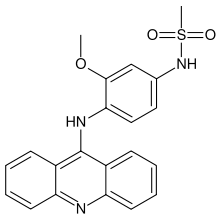Amsacrine
Amsacrine (synonyms: m-AMSA, acridinyl anisidide) is an antineoplastic agent.
 | |
| Clinical data | |
|---|---|
| ATC code | |
| Legal status | |
| Legal status |
|
| Pharmacokinetic data | |
| Protein binding | 96 to 98% |
| Elimination half-life | 8–9 hours |
| Identifiers | |
| |
| CAS Number | |
| PubChem CID | |
| DrugBank | |
| ChemSpider | |
| UNII | |
| KEGG | |
| ChEBI | |
| ChEMBL | |
| CompTox Dashboard (EPA) | |
| ECHA InfoCard | 100.051.887 |
| Chemical and physical data | |
| Formula | C21H19N3O3S |
| Molar mass | 393.46 g·mol−1 |
| 3D model (JSmol) | |
| |
| |
| (verify) | |
It has been used in acute lymphoblastic leukemia.[1]
Mechanism
Its planar fused ring system can intercalate into the DNA of tumor cells, thereby altering the major and minor groove proportions. These alterations to DNA structure inhibit both DNA replication and transcription by reducing association between the affected DNA and: DNA polymerase, RNA polymerase and transcription factors.
Amsacrine also expresses topoisomerase inhibitor activity, specifically inhibiting topoisomerase II (compares with the better known agent etoposide).[2] In contrast, the structurally similar o-AMSA differing in the position of the methoxy substituent group on the anilino-ring have little ability to poison topoisomerase II despite of its intercalative behavior, suggesting that intercalation of the molecule in itself is insufficient to trap topoisomerase II as a covalent complex on DNA.[3][4][5]
References
- Horstmann MA, Hassenpflug WA, zur Stadt U, Escherich G, Janka G, Kabisch H (December 2005). "Amsacrine combined with etoposide and high-dose methylprednisolone as salvage therapy in acute lymphoblastic leukemia in children". Haematologica. 90 (12): 1701–3. PMID 16330449.
- Bibudhendra S (1995). Genetic Response to Metals. CRC Press. ISBN 978-0-8247-9615-0.
- Wadkins RM, Graves DE (December 1989). "Thermodynamics of the interactions of m-AMSA and o-AMSA with nucleic acids: influence of ionic strength and DNA base composition". Nucleic Acids Research. 17 (23): 9933–46. doi:10.1093/nar/17.23.9933. PMC 335223. PMID 2602146.
- DeMarini DM, Doerr CL, Meyer MK, Brock KH, Hozier J, Moore MM (September 1987). "Mutagenicity of m-AMSA and o-AMSA in mammalian cells due to clastogenic mechanism: possible role of topoisomerase". Mutagenesis. 2 (5): 349–55. doi:10.1093/mutage/2.5.349. PMID 2830452.
- Nitiss JL (May 2009). "Targeting DNA topoisomerase II in cancer chemotherapy". Nature Reviews. Cancer. 9 (5): 338–50. doi:10.1038/nrc2607. PMC 2748742. PMID 19377506.